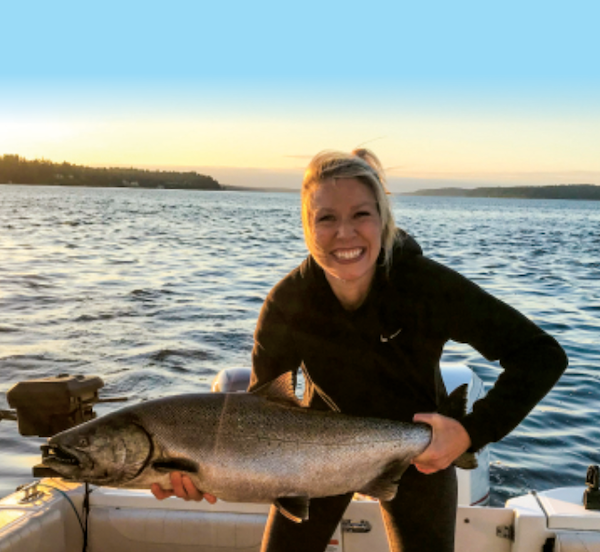
So About That (Brief) Marine Area 13 Salmon Closure …
Well … look at the bright side, Deep South Sound salmon anglers: At least the closure didn’t last that long, although it appears to have been unnecessary to begin with.
Approximately 2 days, 11 hours and 31 minutes into the unexpected Marine Area 13 fishing shutdown, the Washington Department of Fish and Wildlife late this morning announced via an emailed rule change notice that the waters off Steilacoom, Dupont, Fox Island and Olympia were reopening “immediately” for Chinook and coho.

It was a rather sudden and jarring U-turn, given that it followed on an agency rule change late last week that had suspended salmon fishing effective 12:01 a.m., Monday, August 29, because “Expected catches in both recreational and tribal fisheries are below pre-season expectation to date, indicating that returns may be coming in below pre-season forecasts.”
So about the actual numbers behind those low expected catches and returns that were thought to be below forecast …
Mark Baltzell, the WDFW salmon manager who made the call, explained that he had been looking at several things.
South Sound fishermen he trusted were telling him they were just not seeing as many fish around or on their fishfinders as usual, and catches were subpar.
Baltzell acknowledges that that information was anecdotal, but he says there was also concern at the time about catches in a Nisqually Tribe inriver fishery and what that might mean for both broodstock goals and an effort to seed salmon further up the Mt. Rainier tributary.
For Baltzell, it all amounted to an “oh sh*t” moment. Puget Sound fall Chinook are a federally listed stock, important to recreational and tribal fisheries, and a key feedstock for southern resident killer whales.
So last Friday afternoon saw him recommending the Area 13 closure to WDFW Director Kelly Susewind, who signed off on it.
What caught my attention at that time was how rare of a move it was for waters that are otherwise always open year-round for Chinook. Off the top of this hook-and-bullet reporter’s memory (and not counting inseason chum and coho restrictions), the only other closures of the king fishery that I can recall were nonfish-run-related stuff – Governor Jay Inslee’s infamous six-week fishing and hunting shutdown in the early days of Covid and a temporary pause around receiving a needed federal fishery permit a couple seasons ago.
Meanwhile, what a difference a couple late August days makes.
This week, after checking with tribal comanagers, Baltzell says there now appears to be “some relief” in Nisqually catches, adding that the river’s return may just be a week or two late, and fish are otherwise showing up at Minter Creek and elsewhere in Deep South Sound.
Thus today’s reopener.
The agency’s rule change puts it this way: “Chinook salmon returns to the Nisqually river were below pre-season expectation through last Friday, when WDFW paused recreational salmon fishing. After discussions with co-managers and evaluating current information, WDFW is comfortable that management objectives will not be compromised by reopening recreational salmon fishing.”
In this heavily ESA-listed salmon fishing world, anglers from Buoy 10 to Brewster, the San Juans to the Snake have grown used to lots of inseason rule changes as fishery data indicates quotas have been crashed, dam counts show many more fish than expected are arriving, hatchery collection goals are woefully short or tribal or commercial netting suggests run strength is higher than expected, allowing for more recreational harvest opportunity.
But the Area 13 situation is a bit maddening and won’t make the job of being a WDFW-manager-of-anything any easier. It’s leading to fair criticism from constituents, even as we can certainly relate to comparing catch rates in our fishing circles to get a feel for how a run is shaping up, or isn’t, and adjusting our efforts and/or bellyache as the situation calls for.
Thumbs up to Baltzell for offering to be “really honest and candid” with me in taking my call and explaining what happened. My sense about him has always been he’s a guy who wants us to fish and is doing what he can in an increasingly difficult time to get us as much opportunity as possible.
He admits to “eating a lot of humble pie” and acknowledges it was “my bad for pulling the trigger” on the temporary closure.
“If I were to do it again, I wouldn’t have done anything,” he states.
Baltzell does say he learned a few lessons as well, including gathering more data points, talking to the tribes and “never pull the trigger on something like that on a Friday afternoon.”
Here’s to fewer end-of-the-work-week-news-releases-and-run dumps, and unnecessary fishery restrictions.
